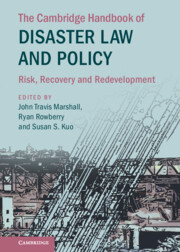Book contents
- The Cambridge Handbook of Disaster Law and Policy
- The Cambridge Handbook of Disaster Law and Policy
- Copyright page
- Dedication
- Contents
- Figures
- Maps
- Tables
- Contributors
- Foreword: Current Trends in Disaster Law and Policy
- Acknowledgments
- Introduction
- Part I Critical Perspectives on the Evolution of Disaster Law and Policy
- Part II Effective Governance as an Imperative for Responsive Disaster Law and Policy
- 3 Governance Structures for Recovery and Resilience
- 4 Governance Strategies for Mitigating Urban Heat Island Effect
- 5 Regulatory Institutional Considerations for Preventing Mining Dam Disasters in Brazil
- 6 Integrating Disaster Risk Reduction and Climate Change Adaptation in the Context of Sustainable Development in Africa
- 7 Climate Resilience in the Greater Bay Area of South China
- 8 An Adaptive Legal Framework for Water Security Concerns in the Guangdong-Hong Kong-Macao Greater Bay Area
- Part III Law’s Role in Promoting Hazard Mitigation: Intergovernmental, International, National, and Local Approaches
- Part IV Private Sector Initiatives to Promote Disaster Resilience and Recovery
- Part V Lawyers As Disaster Law and Policy Leaders: Training for Students and Guidance for Practitioners
- Part VI Cultural Heritage Protection and Cross-Disciplinary Opportunities for Advancing Disaster Law and Policy
- Part VII Disasters and Vulnerable Communities
8 - An Adaptive Legal Framework for Water Security Concerns in the Guangdong-Hong Kong-Macao Greater Bay Area
from Part II - Effective Governance as an Imperative for Responsive Disaster Law and Policy
Published online by Cambridge University Press: 27 October 2022
- The Cambridge Handbook of Disaster Law and Policy
- The Cambridge Handbook of Disaster Law and Policy
- Copyright page
- Dedication
- Contents
- Figures
- Maps
- Tables
- Contributors
- Foreword: Current Trends in Disaster Law and Policy
- Acknowledgments
- Introduction
- Part I Critical Perspectives on the Evolution of Disaster Law and Policy
- Part II Effective Governance as an Imperative for Responsive Disaster Law and Policy
- 3 Governance Structures for Recovery and Resilience
- 4 Governance Strategies for Mitigating Urban Heat Island Effect
- 5 Regulatory Institutional Considerations for Preventing Mining Dam Disasters in Brazil
- 6 Integrating Disaster Risk Reduction and Climate Change Adaptation in the Context of Sustainable Development in Africa
- 7 Climate Resilience in the Greater Bay Area of South China
- 8 An Adaptive Legal Framework for Water Security Concerns in the Guangdong-Hong Kong-Macao Greater Bay Area
- Part III Law’s Role in Promoting Hazard Mitigation: Intergovernmental, International, National, and Local Approaches
- Part IV Private Sector Initiatives to Promote Disaster Resilience and Recovery
- Part V Lawyers As Disaster Law and Policy Leaders: Training for Students and Guidance for Practitioners
- Part VI Cultural Heritage Protection and Cross-Disciplinary Opportunities for Advancing Disaster Law and Policy
- Part VII Disasters and Vulnerable Communities
Summary
To tackle hydrological hazards, an adaptive legal framework based on biophysical and social conditions is essential at emerging conurbations involving multiple water administrations. To secure sustainable natural resources and improve livelihoods, Chinese laws stipulate policies that guide water governance and regulate hazards. The Guangdong-Hong Kong-Macao Greater Bay Area (GBA) in China is a regional development initiative which requires a novel and flexible transboundary legal framework for its increasingly complex and uncertain water systems due to unprecedented climate variability and socioeconomic connections. This legal framework should be able to deal with water availability, accessibility, and hazard prevention issues. It should also be able to address limitations of vagueness, rigidity, and fragmentation in the existing Chinese water legal framework. Therefore, this adaptive legal framework is suggested to manage complexities and uncertainties of regional water security issues, based on big data and social participation. Rapidly advancing big data approaches play important roles in visualizing biophysical conditions of water systems to provide tangible evidence for decision making processes. Meanwhile, participatory approaches aim to motivate the public to engage in decision making and legal reinforcement for collaborative social regulations. These approaches also facilitate efficient information flow for monitoring and evaluating hazards to support legal improvements within the China’s Five-Year Plan cycle. This chapter provides an integrated hazard management framework for dynamic sustainable development in changing climates by highlighting the importance of big data and social participation. Based on physical and social data over different locations, other regions in the world can draw lessons from this suggested framework to develop an adaptive legal framework for water governance.
- Type
- Chapter
- Information
- The Cambridge Handbook of Disaster Law and PolicyRisk, Recovery, and Redevelopment, pp. 131 - 148Publisher: Cambridge University PressPrint publication year: 2022

